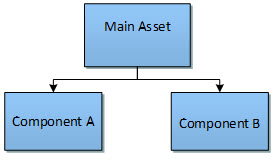Asset management terminology and definitions
The following sections include information about asset management terminology and definitions.
Implementation method
The Sparkrock asset management functionality can be implemented using an integrated or a standalone model.
Integrated model: The financial and purchasing functionality within Sparkrock Impact are used.
Standalone model: The financial, purchasing, and accounts payable functions are being managed in another application. The intention is to maintain a very simple chart of accounts in the Sparkrock Impact general ledger which includes only accounts related to asset transactions. Any data that is to be extracted for integration purposes to another general ledger is pulled from the Sparkrock Impact general ledger.
Capital assets
Capital Assets are non-financial assets with physical substance that have the following characteristics:
Capital assets are held for use in the production or supply of goods and services, for rental to others, for administrative purposes, or for the development, construction, maintenance, or repair of other tangible capital assets.
Capital assets have useful economic lives extending beyond an accounting period.
Capital assets are to be used on a continuing basis.
Capital assets are not for sale in the ordinary course of operations.
Typically, Capital Assets and Fixed Assets are terms that are used interchangeably.
Pooled assets
A pooled asset is a single asset record that represents multiple assets or transactions flowing through the asset. Non-pooled assets are a unique asset that equals an asset record.
For more information see, Pooled assets.
Construction in Progress
Construction in Progress (CIP) assets refer to new capital asset construction projects that are not completed and are not ready to be put into service. New building construction, the addition of a parking to an existing building, and similar expenditures qualify as construction in progress. Betterments made to an existing building are not construction in progress assets.
Construction in progress projects are not amortized until construction is completed and the asset is ready to be put into service.
Interest expenses that are related to financing costs that are incurred during the time the asset is under construction are capitalized as part of the construction costs.
Assets under construction are to be transferred out to an appropriate tangible asset class when the construction is substantially complete and the asset is ready for use.
Asset structure
Assets can be created as sub-assets or components of main assets. The link between the main assets and the components allows summarized reporting and grouping by main asset. This structure can be used to combine multiple assets that represent projects of betterments to a building with the building asset itself. The main asset and each of the components can have their own depreciation start date and depreciation period.

Locations and sub locations
A location record is typically set up for each physical location address, such as the main office and each individual location. Sub location records can be set up to track locations, areas, buildings, departments, or wings within a location. These values are not passed through to the general ledger, but are used to track the physical location of an asset.
Capital asset class and capital asset subclass
Capital asset class and capital asset subclass are categorizations of assets. In implementations of the Sparkrock asset management functionality, the asset subclass is a sub grouping of the asset class. Many of the reports can be generated with subtotals for either level.
Depreciation book
A depreciation book is a setup component within Sparkrock Impact that defines parameters that are related to asset transactions. The number of the depreciation books that are being created depends on the number of depreciation calculations that must be tracked by an asset. This functionality allows the asset to be depreciated in more than one way at the same time, such as computing depreciation for accounting purposes according to one schedule and computing depreciation for tax purposes according to another schedule. Typically, only one of these books is integrated to the general ledger.
FA depreciation book
Each combination of a fixed asset number and a depreciation book code is called an FA depreciation book.
Contra accounts
A contra account is an account that offsets the balance that is booked to another account. The purpose of the contra account in the Sparkrock Impact asset management functionality is to allow asset purchase transactions to be booked on an expense account at the same time as the asset account. This design enables Sparkrock Impact to provide budget control. The expense account is offset against the accounts payable account. The balance sheet asset account is offset against the contra account.
Depreciation
For the purpose of this document depreciation and amortization are used interchangeably. Depreciation is the gradual conversion of the cost of a capital asset into an operating expense. The annual depreciation amount is calculated as the cost of the asset less the asset's estimated residual value over the estimated useful life of the capital asset.
Tangible capital assets setup checklist
| Information | Page | Comments |
|---|---|---|
| Accounting | FA Posting Group Journal Templates Reclass Journal Templates |
Set up FA posting and allocation key. Set up journal templates. |
| Basic Depreciation Set Up | Depreciation Book FA Journal Setup |
Defines various depreciation rules, integration with the general ledger and information that allows duplication of entries in several depreciation books. Define a default journal setup for each depreciation book. |
| Basic General Information | Fixed Asset Setup FA Classes FA Subclasses FA Locations and Sub-locations |
Set up number prefixes and default asset depreciation book. Create values for asset classes, subclasses, locations, and sub-locations. |
| Capital Assets | Fixed Assets | Define different reporting metrics and classifications specify the method of depreciation for each capital asset. |
| Employee Portal | Expense Type Categories Expense Types |
Define the setup necessary to acquire capital tangible assets as part of the standard purchase process. |
Feedback
To send feedback about this page, select the following link:
